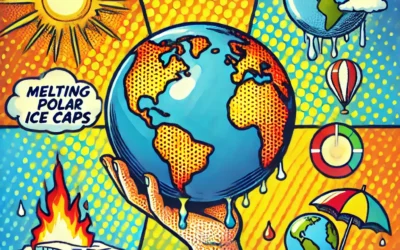Carbon Offset: A Solution for Climate Change?
A carbon offset is a way of compensating for the emissions of greenhouse gases that are caused by human activities. It is a reduction, avoidance, or removal of emissions that is done to balance out the emissions that are produced elsewhere.
For example, if you fly from New York to London, you can buy a carbon offset to support a project that reduces emissions in another location, such as a wind farm in India or a forest restoration in Brazil. By doing so, you can claim to have a neutral or even negative carbon footprint for your flight.
How Do Carbon Offsets Work?
Carbon offsets work by creating a market for emissions reductions. There are two main types of carbon offset markets: voluntary and compliance. The voluntary market is where individuals, businesses, and organizations choose to buy and sell carbon offsets for their own reasons, such as corporate social responsibility, environmental awareness, or personal satisfaction.
The compliance market is where governments, regions, or sectors are required by law or regulation to reduce their emissions to a certain level, and can use carbon offsets to meet part of their obligations.
In both markets, carbon offsets are created by projects that reduce, avoid, or remove emissions in various ways, such as:
- Renewable energy: Generating electricity from sources that do not emit greenhouse gases, such as wind, solar, hydro, or biomass.
- Energy efficiency: Improving the performance of devices, buildings, or processes that use energy, such as lighting, heating, cooling, or manufacturing.
- Methane capture: Preventing or capturing the emissions of methane, a potent greenhouse gas, from sources such as landfills, animal waste, or coal mines.
- Forest conservation: Protecting existing forests from deforestation or degradation, which release carbon dioxide when trees are cut down or burned.
- Reforestation: Planting new trees or restoring degraded lands, which absorb carbon dioxide as they grow.
- Carbon capture and storage: Capturing carbon dioxide from industrial sources or the air, and storing it underground or in other forms, such as minerals or algae.
Each carbon offset project is measured and verified by independent third parties, who ensure that the project meets certain standards and criteria, such as:
- Additionality: The project must result in emissions reductions that are additional to what would have happened otherwise, i.e., without the project.
- Permanence: The project must ensure that the emissions reductions are permanent and not reversible, i.e., the carbon is not released back into the atmosphere.
- Leakage: The project must prevent or account for any displacement of emissions, i.e., the project does not cause emissions to increase elsewhere.
- Co-benefits: The project must consider and report on the social, economic, and environmental impacts of the project, i.e., the project does not harm the well-being of people or nature.
Each carbon offset project is issued with carbon credits, which are units that represent the amount of emissions that are reduced, avoided, or removed by the project. One carbon credit is equivalent to one tonne of carbon dioxide, or its equivalent in other greenhouse gases.
Carbon credits can be bought and sold in the carbon offset market, either directly between buyers and sellers, or through intermediaries such as brokers, retailers, or platforms. The price of carbon credits depends on various factors, such as the type, location, and quality of the project, the supply and demand of the market, and the negotiation between the parties.
What Are the Benefits of Carbon Offsets?
Carbon offsets can have various benefits for the climate, the environment, and the society. Some of the benefits are:
Climate: Carbon offsets can help to reduce the global greenhouse gas emissions, which are the main cause of climate change. By supporting projects that reduce, avoid, or remove emissions, carbon offsets can contribute to the goal of limiting the global temperature rise to well below 2°C, preferably to 1.5°C, compared to pre-industrial levels. This can help to prevent the worst effects of climate change, such as melting ice caps, rising sea levels, extreme weather events, and loss of biodiversity.
Environment: Carbon offsets can also help to conserve and restore the natural resources and ecosystems that are essential for life on Earth. By supporting projects that protect and enhance forests, wetlands, grasslands, and oceans, carbon offsets can preserve the biodiversity, water, soil, and air quality that are vital for the health and well-being of humans and other species.
Society: Carbon offsets can also help to improve the livelihoods and well-being of millions of people around the world. By supporting projects that provide clean and renewable energy, improve energy efficiency, and reduce poverty and inequality, carbon offsets can create jobs, income, education, health, and empowerment for the local communities that are involved in or affected by the projects.
What Are the Challenges of Carbon Offsets?
Carbon offsets are not without challenges and limitations. Some of the challenges are:
Quality: Carbon offsets can vary in quality depending on the type, location, and verification of the project. Some projects may not deliver the expected emissions reductions, or may have negative impacts on the environment or the society. Therefore, it is important to choose carbon offsets that are credible, transparent, and verified by reputable standards and organizations.
Additionality: Carbon offsets can be difficult to prove that they are additional, i.e., that they result in emissions reductions that would not have happened otherwise. Some projects may be overestimated, double-counted, or already funded by other sources. Therefore, it is important to ensure that carbon offsets are based on realistic and conservative assumptions, and that they are not claimed by more than one party.
Permanence: Carbon offsets can be uncertain in terms of their permanence, i.e., that they ensure that the emissions reductions are permanent and not reversible. Some projects may be vulnerable to natural or human-induced risks, such as fires, pests, diseases, or conflicts, that may release the carbon back into the atmosphere. Therefore, it is important to monitor and verify the carbon offsets over time, and to have safeguards and buffers in case of any losses or reversals.
Leakage: Carbon offsets can be problematic in terms of their leakage, i.e., that they prevent or account for any displacement of emissions. Some projects may cause emissions to increase elsewhere, either directly or indirectly, by changing the behavior or incentives of the actors involved. For example, a project that protects a forest in one area may lead to deforestation in another area, or a project that reduces the demand for fossil fuels in one country may lower the price and increase the consumption of fossil fuels in another country. Therefore, it is important to assess and mitigate the potential leakage effects of carbon offsets, and to include them in the calculation of the emissions reductions.
Equity: Carbon offsets can raise issues of equity and justice, both within and between countries. Some projects may benefit some groups or regions more than others, or may create or exacerbate conflicts or inequalities among the stakeholders. For example, a project that protects a forest may deprive the local communities of their access to land and resources, or a project that sells carbon credits may transfer the responsibility and cost of emissions reductions from the developed to the developing countries. Therefore, it is important to ensure that carbon offsets are fair and inclusive, and that they respect the rights and interests of all the parties involved.
Conclusion
Carbon offsetting is a way of compensating for the emissions of greenhouse gases that are caused by human activities. It is a reduction, avoidance, or removal of emissions that is done to balance out the emissions that are produced elsewhere.
Carbon offsetting can help to fight climate change, while also generating other benefits for the environment and the society. However, carbon offsetting is not a substitute for reducing emissions, but a complement. We need to reduce our emissions drastically and rapidly, and use carbon offsets to cover the remaining emissions that we cannot avoid or reduce.
Learn more:






